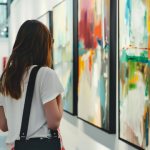Preparing art for a show is an exciting yet meticulous process. It involves more than just creating artwork; it requires careful planning and attention to detail to ensure your pieces are presented best. Whether participating in a local exhibition or a prestigious art gallery show, here’s a comprehensive guide on preparing your art for display.
Forge a Connection with the Venue and Audience
Research the Venue
- Size and Layout: Understand the dimensions and layout of the venue to determine how many pieces you can exhibit and how they might be arranged.
- Theme and Style: Consider the gallery’s style and the exhibition’s theme. Aligning your work with these aspects can enhance its appeal.
Know Your Audience
- Target Demographic: Tailor your artwork’s presentation to resonate with the expected Audience.
- Cultural and Social Context: Consider the cultural context and preferences of the Audience to ensure relevance and impact.
Select and Curate Your Artwork
Choose the Right Pieces
- Quality Over Quantity: Select pieces that best represent your artistic voice and the message you wish to convey.
- Cohesion: Ensure a cohesive theme or style among selected works to present a unified body of work.
Curate Thoughtfully
- Narrative: Create a narrative or flow between the pieces. This can guide viewers through your work and offer a deeper understanding of your artistic vision.
- Variety: While maintaining cohesion, provide a variety of sizes, mediums, or subjects to engage viewers.
Prepare the Artwork Physically
Framing and Matting
- Quality Materials: Use archival-quality materials to protect your artwork and enhance its presentation.
- Style and Color: Choose frames and mats that complement, not overpower, the artwork. Consider simple frames for modern art and more ornate options for classical pieces.
Mounting and Hanging
- Secure Methods: Use secure mounting techniques, such as D-rings and picture wire, to prevent damage.
- Consistency: Ensure all pieces have a consistent hanging mechanism to simplify installation at the venue.
Protective Measures
- Varnishing: Consider varnishing paintings to protect them from dust, UV rays, and physical damage.
- Packaging: Use bubble wrap, cardboard corners, and other protective materials during transport to prevent damage.
Labeling and Documentation
Create Labels
- Essential Information: Include the title, medium, dimensions, and price (if applicable) on each label.
- Professional Presentation: Use uniform, easy-to-read labels that match the exhibition’s style guide.
Prepare Documentation
- Artist Statement: Craft a concise statement explaining your artistic philosophy and the inspiration behind the exhibited works.
- Catalog: If required, prepare a catalog of your works with high-quality images and detailed descriptions.
Marketing and Promotion
Build Hype
- Social Media: Leverage platforms like Instagram, Facebook, and TikTok to share teasers of your work and event details.
- Press Releases: Send press releases to local media, art blogs, and relevant publications.
Engage with the Audience
- Invitations: Send personal invitations to friends, family, collectors, and influencers to generate buzz.
- Artist Talks: Consider offering an artist talk or tour to engage directly with attendees.
Logistics and Installation
Coordinate Transport
- Professional Services: Consider hiring a professional art transportation service to deliver your artwork to the venue safely.
- Timing: Arrange transportation well in advance to account for any unforeseen delays.
Plan Installation
- Layout Plan: Work with the curator to plan the installation, ensuring optimal spacing and lighting for each piece.
- Tools and Equipment: Bring necessary tools and equipment, such as hammers, levels, and ladders, for installation.
Engage with the Event
Attend the Opening
- Networking: Use the opportunity to meet collectors, fellow artists, and potential buyers.
- Feedback: Gather Feedback from visitors to understand how your work resonates with them.
Be Present
- Interaction: Engage with attendees, answer questions, and discuss your work to build a connection with the Audience.
- Follow-up: After the Event, follow up with new contacts, thank attendees, and maintain engagement through newsletters or social media.
Post-Exhibition Tasks
Artwork Retrieval
- Coordinate Pickup: Arrange for timely Pickup of your artwork after the show concludes.
- Inspect for Damage: Check each piece for any damage that may have occurred during the exhibition.
Sales and Transactions
- Finalize Sales: Complete any sales transactions, ensuring all paperwork and payments are handled professionally.
- Invoices and Receipts: Provide buyers with official purchase invoices and receipts.
Reflect and Evaluate
Review Performance
- Analyze Feedback: Review Feedback and sales data to understand what worked and what could be improved.
- Set Goals: Use insights gained to set goals for future exhibitions, enhancing your artistic growth and career trajectory.
Learn from Experience
- Document Lessons: Keep a record of lessons learned, successes, and areas for improvement to refine your approach for future shows.
Conclusion
Preparing art for a show is a multifaceted process beyond creating the work itself. By carefully considering each step—from selection and physical preparation to marketing and engagement—you can ensure that your artwork significantly impacts your Audience. This meticulous approach will enhance your presentation and pave the way for future successes in the art world




